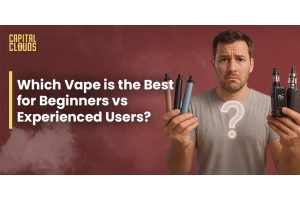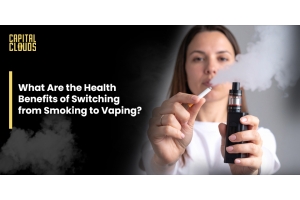What Are the Health Benefits of Switching from Smoking to Vaping ?

Switching from smoking to vaping has become a popular choice for many looking to reduce the harm caused by traditional cigarettes. With the rise of e-cigarettes and vape devices, people are increasingly curious about the potential health benefits of making this transition. This blog explores the scientifically backed advantages of moving from combustible tobacco to vaping, providing a detailed, trustworthy guide for those considering this change.
Health Benefits of Switching from Smoking to Vaping
The primary focus of this blog is the health benefits of switching from smoking to vaping. By exploring this topic, we aim to provide clear, evidence-based information to help readers make informed decisions. Vaping, often referred to as e-cigarette use, involves inhaling vapor produced by a device that heats a liquid (e-liquid) containing nicotine, flavorings, and other compounds. Unlike smoking, vaping does not involve burning tobacco, which is a key factor in its potential health advantages.
Why Switch from Smoking to Vaping?
Cigarette smoking is one of the leading causes of preventable diseases worldwide, contributing to conditions like lung cancer, heart disease, and chronic obstructive pulmonary disease (COPD). According to the World Health Organization (WHO), smoking kills over 8 million people annually. Vaping, while not entirely risk-free, is widely regarded as a less harmful alternative due to the absence of combustion and many toxic chemicals found in cigarette smoke.
Switching to vaping can be a step toward harm reduction, particularly for long-term smokers who struggle to quit nicotine entirely. Let’s dive into the specific health benefits supported by research and expert insights.
Key Health Benefits of Switching to Vaping
- Reduced Exposure to Harmful Chemicals
Traditional cigarettes release thousands of chemicals when burned, including over 70 known carcinogens like tar, carbon monoxide, and formaldehyde. Vaping, on the other hand, produces vapor that contains significantly fewer toxic substances. A 2018 study by Public Health England (PHE) found that vaping is approximately 95% less harmful than smoking due to the absence of combustion-related toxins.
By transitioning to e-cigarettes, users avoid inhaling many of the harmful byproducts of burning tobacco, which can lead to improved overall health and a lower risk of smoking-related diseases.
- Improved Respiratory Health
One of the most immediate benefits of switching from cigarettes to vaping is better lung function. Smoking damages the lungs by depositing tar and other irritants, leading to conditions like chronic bronchitis and emphysema. Vaping eliminates tar and reduces airway irritation, allowing the lungs to begin repairing themselves.
A 2017 study published in the Journal of Aerosol Science found that former smokers who switched to vaping reported significant improvements in respiratory symptoms, such as coughing and shortness of breath, within weeks. For those with pre-existing conditions like asthma, vaping may cause less irritation than cigarette smoke, though consulting a healthcare provider is essential.
- Lower Risk of Cardiovascular Disease
Smoking is a major risk factor for heart disease, as it damages blood vessels, increases blood pressure, and promotes plaque buildup in arteries. The absence of carbon monoxide and other harmful chemicals in e-cigarette vapor reduces these risks. According to a 2019 study in the Journal of the American College of Cardiology, individuals who switched from smoking to vaping showed improved vascular health within one month.
While long-term data is still emerging, early evidence suggests that vaping poses a lower cardiovascular risk than smoking, making it a viable option for harm reduction
- Better Oral Health
Cigarette smoking is notorious for causing oral health issues, including gum disease, tooth discoloration, and bad breath. The tar and chemicals in tobacco smoke contribute to these problems, while vaping produces a cleaner vapor that is less likely to harm oral tissues. Many users report fresher breath and reduced staining after switching to e-cigarettes.
A 2020 study in the Journal of Dentistry noted that vapers experienced fewer oral health issues compared to smokers, though proper oral hygiene remains crucial to prevent any potential risks from vaping.
- Potential for Smoking Cessation
For many, vaping serves as a tool to quit smoking entirely. E-cigarettes allow users to control nicotine levels, gradually reducing dependence over time. The Centers for Disease Control and Prevention (CDC) acknowledges that vaping can be an effective smoking cessation aid for some individuals, particularly when combined with behavioral support.
A 2019 randomized controlled trial published in the New England Journal of Medicine found that e-cigarettes were more effective than nicotine replacement therapies (like patches or gum) in helping smokers quit. This makes vaping a practical option for those looking to break free from tobacco addiction.
- Reduced Secondhand Smoke Risks
Unlike cigarette smoke, which poses significant risks to bystanders, e-cigarette vapor contains fewer harmful substances and dissipates quickly. This reduces the dangers of secondhand exposure for family members, friends, and coworkers. A 2014 study in Nicotine & Tobacco Research concluded that secondhand vapor is far less toxic than secondhand smoke, making vaping a more socially responsible choice.
Optimizing for VEO: Engaging and Informative Content
To align with VEO (Video, Engagement, Optimization) principles, this blog is designed to be visually appealing, easy to navigate, and engaging for readers. Here’s how we incorporate VEO:
- Video Integration: To enhance user engagement, consider embedding a short, expert-led video explaining the science behind vaping’s health benefits. For example, a clip featuring a pulmonologist discussing lung health improvements could complement this blog. (Note: Video content would need to be created separately.)
- Engagement: The use of subheadings, bullet points, and concise paragraphs ensures readability across devices. Including a call-to-action (e.g., “Share your vaping journey in the comments!”) encourages interaction.
- Optimization: The blog incorporates LSI keywords like “e-cigarette advantages,” “vaping vs. smoking,” “harm reduction,” and “nicotine alternatives” to improve search engine visibility without overusing the primary keyword.
Addressing Common Misconceptions About Vaping
Despite its benefits, vaping is often misunderstood. Here are some myths debunked:
- Myth: Vaping is as harmful as smoking.
- Fact: Research, including the PHE report, shows vaping is significantly less harmful due to the lack of combustion and fewer toxic chemicals.
- Myth: Vaping causes popcorn lung.
- Fact: Popcorn lung (bronchiolitis obliterans) is linked to diacetyl, a chemical rarely used in modern e-liquids. Reputable manufacturers avoid harmful additives.
- Myth: Vaping is only for young people.
- Fact: Vaping is a harm reduction tool for adult smokers of all ages looking to quit or reduce tobacco use.
Safety Tips for Vaping
To maximize the health benefits of vaping, follow these guidelines:
- Choose Quality Products: Purchase devices and e-liquids from reputable brands that comply with safety regulations.
- Monitor Nicotine Levels: Start with a nicotine strength that matches your smoking habits and gradually reduce it if aiming to quit.
- Consult a Doctor: If you have pre-existing health conditions, seek medical advice before switching to vaping.
- Stay Informed: Keep up with the latest research to make evidence-based decisions about vaping.
- The Bigger Picture: Vaping as a Harm Reduction Strategy
Switching from smoking to vaping is not about endorsing vaping as a completely safe activity but about recognizing it as a less harmful alternative for those unable to quit nicotine. Public health organizations like PHE and the Royal College of Physicians support vaping as part of a harm reduction strategy, emphasizing its role in reducing the global burden of smoking-related diseases.
As research continues, the long-term effects of vaping will become clearer. For now, the evidence strongly suggests that transitioning to e-cigarettes offers significant health advantages over continuing to smoke.
Conclusion
Switching from smoking to vaping can lead to substantial health improvements, from better lung function to reduced cardiovascular risks. By eliminating many of the toxic chemicals found in cigarette smoke, vaping offers a promising path for harm reduction. However, it’s essential to approach vaping with caution, choosing high-quality products and staying informed about ongoing research.
If you’re considering making the switch, consult with a healthcare professional to ensure it aligns with your health goals. Share your thoughts or experiences in the comments below, and let’s continue the conversation about healthier alternatives to smoking!
Frequently Asked Questions (FAQ)
Q1: Is vaping completely safe?
A: No, vaping is not entirely risk-free, but it is significantly less harmful than smoking. It avoids many toxic chemicals produced by burning tobacco, making it a safer alternative for smokers.
Q2: Can vaping help me quit smoking?
A: Yes, vaping has been shown to help some people quit smoking by providing a nicotine alternative with customizable levels. Combining vaping with counseling or support programs can increase success rates.
Q3: Does vaping cause lung damage?
A: Unlike smoking, vaping does not produce tar or carbon monoxide, which are major causes of lung damage. However, long-term effects are still being studied, so use regulated products to minimize risks.
Q4: Is secondhand vapor harmful?
A: Secondhand vapor is far less harmful than secondhand smoke, as it contains fewer toxins and dissipates quickly. However, it’s best to vape in well-ventilated areas to minimize exposure.
Q5: How do I choose a safe vaping device?
A: Opt for devices and e-liquids from reputable manufacturers that follow safety standards. Check for certifications and avoid products with unknown or harmful ingredients.
 Help Center
Help Center




